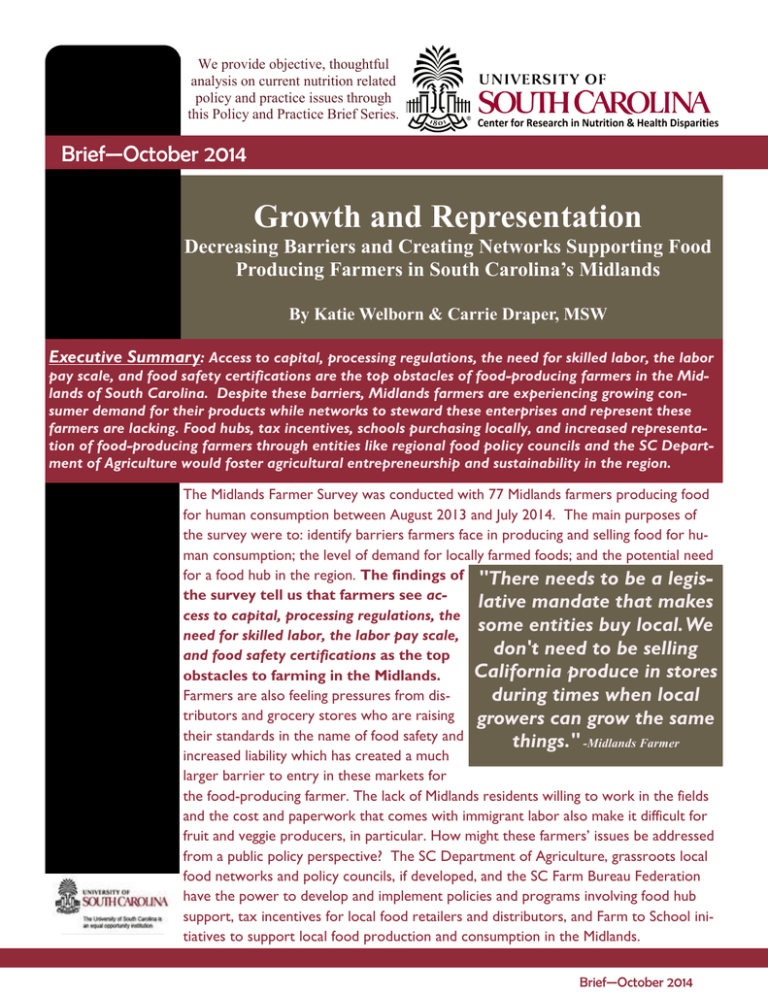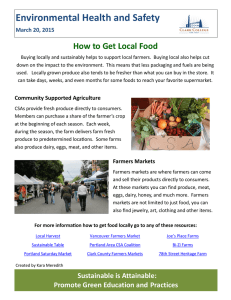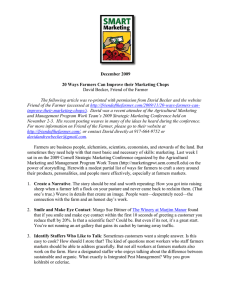Document 14545385
advertisement

We provide objective, thoughtful analysis on current nutrition related policy and practice issues through this Policy and Practice Brief Series. Brief—October 2014 Growth and Representation Decreasing Barriers and Creating Networks Supporting Food Producing Farmers in South Carolina’s Midlands By Katie Welborn & Carrie Draper, MSW Executive Summary: Access to capital, processing regulations, the need for skilled labor, the labor pay scale, and food safety certifications are the top obstacles of food-producing farmers in the Midlands of South Carolina. Despite these barriers, Midlands farmers are experiencing growing consumer demand for their products while networks to steward these enterprises and represent these farmers are lacking. Food hubs, tax incentives, schools purchasing locally, and increased representation of food-producing farmers through entities like regional food policy councils and the SC Department of Agriculture would foster agricultural entrepreneurship and sustainability in the region. The Midlands Farmer Survey was conducted with 77 Midlands farmers producing food for human consumption between August 2013 and July 2014. The main purposes of the survey were to: identify barriers farmers face in producing and selling food for human consumption; the level of demand for locally farmed foods; and the potential need for a food hub in the region. The findings of "There needs to be a legisthe survey tell us that farmers see aclative mandate that makes cess to capital, processing regulations, the some entities buy local. We need for skilled labor, the labor pay scale, don't need to be selling and food safety certifications as the top California produce in stores obstacles to farming in the Midlands. Farmers are also feeling pressures from disduring times when local tributors and grocery stores who are raising growers can grow the same their standards in the name of food safety and things." -Midlands Farmer increased liability which has created a much larger barrier to entry in these markets for the food-producing farmer. The lack of Midlands residents willing to work in the fields and the cost and paperwork that comes with immigrant labor also make it difficult for fruit and veggie producers, in particular. How might these farmers’ issues be addressed from a public policy perspective? The SC Department of Agriculture, grassroots local food networks and policy councils, if developed, and the SC Farm Bureau Federation have the power to develop and implement policies and programs involving food hub support, tax incentives for local food retailers and distributors, and Farm to School initiatives to support local food production and consumption in the Midlands. Brief—October 2014 PAGE 2 Several Key Findings from the Midlands Farmer Survey: 77% of farmers are interested in selling through outlets they do not currently use. 88% of farmers were not GAP certified, with many not knowing what GAP was. “I started to sell to Piggly Wiggly 20 years ago, but now grocers can't buy from the little guys anymore because of all of the laws now." -Midlands Farmer 30% of farmers said they would hire farm labor (or more “Transportation is a HUGE issue farm labor) if it were accessible. for me. How do we create 62% of farmers surveyed are Certified SC Grown. Other than 'Word of Mouth', Certified SC Grown was the #1 way that farmers marketed themselves. efficiencies with delivery and distribution?” -Midlands Farmer Over the past 5 years..... 50% of farmers have seen their profits increase. “Would love to have products in 67% of farmers have seen an increase in their number bricks and mortar so that we of customers. don’t have to physically sell it ourselves. We could focus on the 58% of farmers have increased their production. farm.” -Midlands Farmer Decreasing Barriers to Local Food Entrepreneurship: Food Hubs: A food hub serving as an aggregator and distribution point would assist Midlands farmers and food business entrepreneurs in overcoming many barriers to market entry. How does a farmer jump from selling at farmers markets to meeting the large quantities and specifications of a large distributor or grocery retail outlet? Food Hubs connect farmers collectively with cafeterias, grocery stores, restaurants, etc. and also open up opportunities for commodity crop farmers to diversify and begin producing food for direct human consumption. The Midlands Farm Survey shows farmer interest in selling to more outlets, including a Food Hub to assist with processing, food safety, and distribution. Farm to School: The Certified SC Grown campaign has encouraged customers to purchase locally. How much more of an impact would government food-buying institutions be able to make in fostering local food production if encouraged to do the same? South Carolina school district food procurement practices, such as utilizing the Food Service Alliance to obtain produce cheaply through a distributor-based bid, are not always conducive to local food-producing farmers. The SC Department of Agriculture should work jointly with the district food service coordinators, farmers, distributors, students, and food service employees to determine what works best for each district, incentivize each school to source locally, and outline clear steps for farmers wanting to sell to schools. Tax Incentives: Tax credits for grocers, restaurants, and other food retailers for selling a certain per- centage of SC-farmed product would help incentivize these institutions to request local products from their distributors and work even closer with food producers within South Carolina’s border. Brief—October 2014 PAGE 3 Increasing Local Food Advocacy and Cooperation : Organizations currently representing farmers such as the SC Department of Agriculture and the SC Farm Bureau Federation are tasked with the difficulty of representing all farmers across the spheres of agribusiness and agricultural entrepreneurship, not just the interests of farmers producing food for local human consumption. According "It’s difficult to navigate to the Midlands Farmer Survey, marketing what you can and can’t assistance from these organizations has do in terms of growing, been helpful to farmers, but communicazoning, etc. with tion regarding policy is lacking with many farmers surveyed not understanding resources available to them, different levels of government's laws, rules, and regulations." such as GAP Certification and most are not aware of the Food Safety Modernization Act. Grassroots -Midlands Farmer networks are needed, possibly in the form of food policy councils, to advocate for local food production and consumption and work on issues such as encouraging local and state policies that spur consumer and government food-buying entities to purchase locally. Fostering groups such as the Midlands Local Food Collaborative (http://www.clemson.edu/ extension/midlandslocalfood) would provide space for entities that work with foodproducing farmers on a regular basis to collaborate and close the communication gaps in helping farmers navigate and give their own voices to programs, policies, new opportunities, and regulations that inevitably affect their families and farm enterprises. For further information contact: Katie Welborn Community Organizer welborn2@mailbox.sc.edu 803.360.3358 Carrie Draper, MSW Community & Policy Outreach Director draper@mailbox.sc.edu 803.528.4498 Dr. Sonya Jones Director sjones@mailbox.sc.edu 803.777.3892 University of South Carolina Center for Research in Nutrition & Health Disparities Discovery Building 915 Greene Street Columbia, SC 29208 http://nutritioncenter.sph.sc.edu/index.php The writing of this brief was supported by COPASCities, a project of USC’s Center for Research in Nutrition & Health Disparities. COPASCities is funded through the U.S. Department of Agriculture, AFRI Childhood Obesity Challenge Area and is part of a state-wide initiative to promote food system change. The goal of this project is to increase the capacity of South Carolina community leaders to build practice-based evidence for childhood obesity prevention using food systems strategies. Brief—October 2014





